His plan: Help Charlotte manage its growth
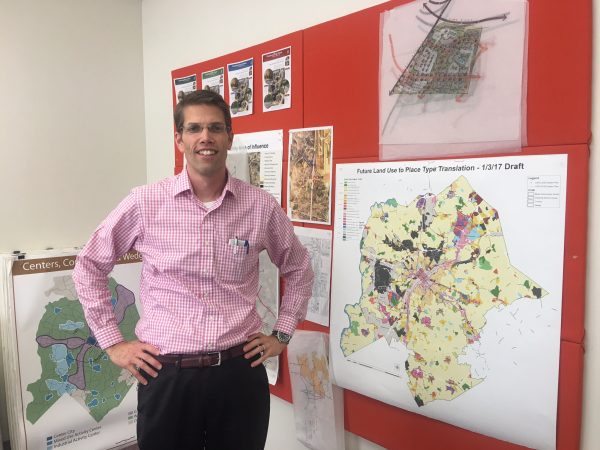
The Charlotte-Mecklenburg Planning Department has begun a large public initiative to produce a new zoning ordinance – the first big rewrite since a contentious one in the 1980s-1990s. PlanCharlotte editor Mary Newsom met with interim Planning Director Ed McKinney to hear how the process is going.
They talked about how to preserve neighborhood character, what the city could do about gentrification, and of course about the updated zoning. It will be part of a new unified development ordinance, which will include today’s cluster of development ordinances governing things such as zoning, subdivisions and tree protections. A number of other N.C. municipalities and counties have unified development ordinances.
McKinney has been interim planning director for Charlotte since September 2014, when former Planning Director Debra Campbell was promoted. Before joining the department in June 2013 he worked for the consulting firms Glatting Jackson and AECOM. He grew up in Milwaukee and got an architecture degree from the University of Wisconsin-Milwaukee and masters’ in architecture and planning from Georgia Tech in Atlanta.
The current city-county zoning ordinance is 23 years old, 830 pages and offers 109 separate zoning designations. The zoning ordinance revision comes after consultants told the city in 2013 that the ordinance – which sets requirements – too often allows the kind of development city plans and policies don’t intend. Charlotte’s city plans aren’t legally enforceable; they outline what the city hopes will happen.
The interview was edited for length and clarity.
Q. Why undertake this huge initiative to change the city’s zoning ordinance?
A. Everyone knows we are one of the fastest growing places in the country. The nature of development has changed, and the expectations of the community have changed. But parts of our ordinance come from a 1950s perspective – its DNA starts there. We did a major update in the early ’90s. I don’t know all the specifics of that process, but it does illustrate why it takes time. It’s absolutely going to be a change people react to. We want to make sure we’re doing it with a foundation of clear expectations. Every line will be reviewed, and certainly we will have debates about what we are trying to achieve. We intend for our process to be deliberate and transparent and methodical. And it takes time.
Q. You and the planning staff have held neighborhood workshops and other meetings to get people talking about something called “place types.” What’s that?
A. Good question. We’re still working to fully define that in the community. For us, it’s a new vocabulary that we’d use to talk about our community.
Right now, for example, our land use plan only describes the use – is it retail, office, business? The zoning ordinance is just a tool to implement our vision. It doesn’t make sense to redesign that tool unless you have a clear sense of what you’re trying to build.
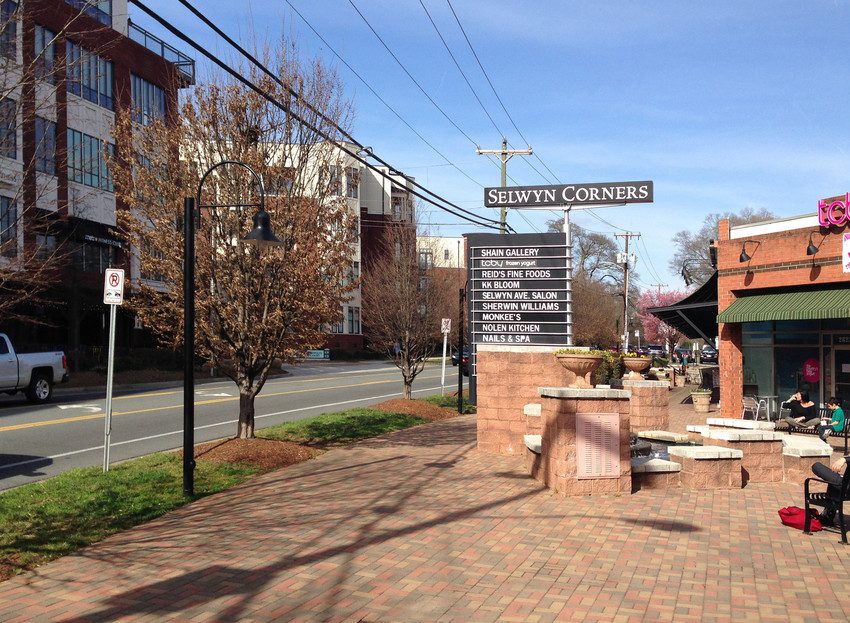
Developments mixing stores, residences and offices at Selwyn Avenue and Colony Road in the Myers Park neighborhood have had to use multiple zoning categories. Photo: David Walters
If we can break our city down into different types of places – with clear community conversations about what those places are and what are their characteristics – then we can say, “Do we have the tools?” Do the zoning ordinance and our development regulations implement the vision we defined?
For example, think of a neighborhood activity center like the area around Selwyn Avenue and Colony Road. Define the characteristics of that place and make sure you have a zoning tool that would let you build it. Today, three, four or five different zoning districts govern that area. Let’s define the vision for a place like that and make sure we’ve got the zoning tools for it, so when we meet with developers our rules and expectations are as clear as we can make them.
Q. Was that a rhetorical question about whether our zoning ordinance lets the city implement the plans’ vision? Didn’t you pay a lot of money a few years ago to consultants who said the ordinance doesn’t?
A. It was rhetorical. Over the last several years we have done some close looking at our ordinance, and the conclusion is that it is time to redesign it and make sure it is building the kind of community we want.
Q. How will a “place type” play a role in the new ordinance?
A. We need to define that more clearly, as we get into the process. Our intent is to make sure there is a stronger link between what we define as a vision and the zoning tools you would use.
Today we do most of our rezoning through negotiated, conditional rezoning. We do it parcel by parcel, case by case. One of the goals we hope to achieve is tools to lessen the need for conditions.
Q. Can these “place types” be fine-grained or localized enough to apply to areas with different character? There are real differences between the mixed-use neighborhoods of NoDa, Cotswold and Ballantyne in terms of history, authenticity, neighborhood feel. Will the new ordinance be able to treat NoDa like NoDa and Ballantyne like Ballantyne?
A. Yes and no. That’s what we’re working on now, trying to figure out how far you can calibrate and define the differences between places like that. But if you go all the way to the extreme, you end up with 100 different place types, and that’s unmanageable. We’re testing how far can you go.
The other answer is that our intent is that the “place types” become the foundation of an area plan. Then the area plans pick up where the place types leave off in terms of the uniqueness and site-specific contexts of the neighborhood.
Q. If we use the term gentrification to mean displacement of lower-income people as neighborhoods become wealthier, what should the city do about that?
A. That issue goes well beyond just the Planning Department. It goes to our housing policy, our policies of business investment and growth and business corridors. But my simple answer is yes. We are always mindful of those issues. We’re very proactive about what we should be doing to deal with this issue of affordable housing.
But it’s not a solution that will come only from the city government. There are lots of other partners needed. And no city has solved that. It’s one of those issues that you can’t solve but you manage – like traffic. We’ve got to be a convener of a lot of partners to address it.
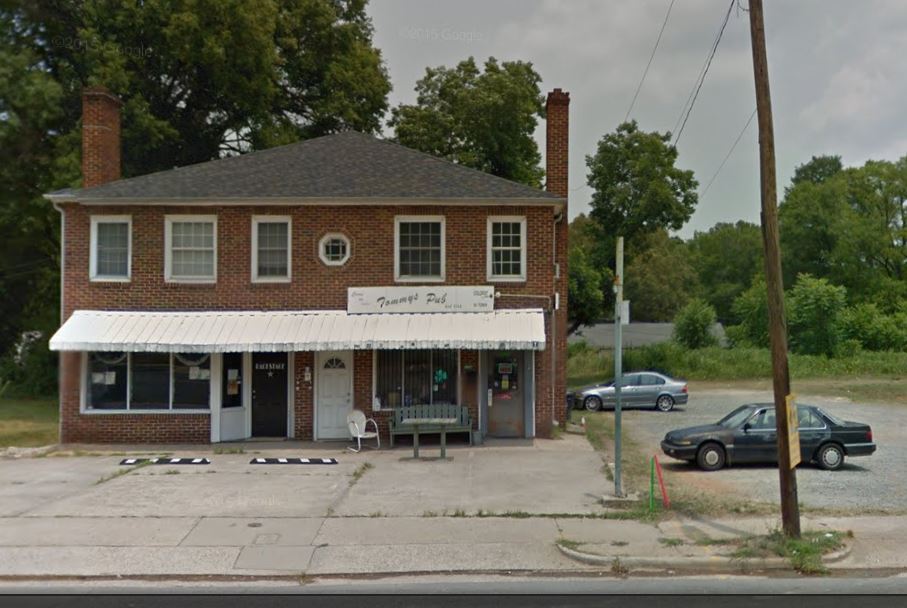
Tommy’s Pub in Plaza Midwood, shown from Google Street View in 2015, was demolished to make way for new development. Photo: Google
Q. If we use “gentrification” to mean losing older stores and businesses that give a neighborhood its authentic character, what should the city do about that?
A. I think we should have a vibrant debate about those places and what is the appropriate scale and form of redevelopment in those kinds of places and then define the rules around them.
If we went through a community discussion about a place like Plaza Midwood, for example, and reconfirm a vision to protect the scale of the corridor and the nature of this business, then your zoning and land use policy might be dramatically different.
As those corridors face this kind of development that’s when that debate starts to rise. It’s important for us to engage the community in that debate. The place type discussion is designed to raise some of those issues.
Q. To continue with your example, if we went through a community discussion about a place like Plaza Midwood and wanted to protect that scale, you said the zoning and land use policy might be dramatically different. In what way?
A. I say all of this having had no discussion with the community, but just as an example: If the notion is we don’t want to see the five- or six-story mixed use projects and want the scale to be more two- to three-story, the way you would regulate that would be dramatically different.
The debate would have to include the economic ramifications of that, and it would include not just residents but property owners. It would be a vibrant conversation about what the appropriate intensity of development is.
One of our opportunities for the ordinance effort is to see if there is a consensus around the nature of those places, and to ensure that we’ve got a zoning tool that defines them.
Q. Many of the planning policies today arose in an era when the city wanted to encourage development close in, because back then it was all about suburbanization. Now there’s intense interest in close-in areas. How much have planners thought updating that mind-set?
A. That really is front and center in my mind. Think about a place like Plaza Midwood. We really don’t have a zoning district designed to achieve that. And then, we need to have a dialog about “achieve what?” Everybody’s thought about that is totally different.
A recent example is the PED overlay in some corridors. It was designed to ensure you get true walkable form, buildings up to the street, buildings scaled so they transition appropriately to the neighborhood. That’s an example of attempts we’ve made to address that emerging need you are describing. But, again, this is a time to go full in and make sure we’ve got that kind of approach for all the issues we have throughout the city.
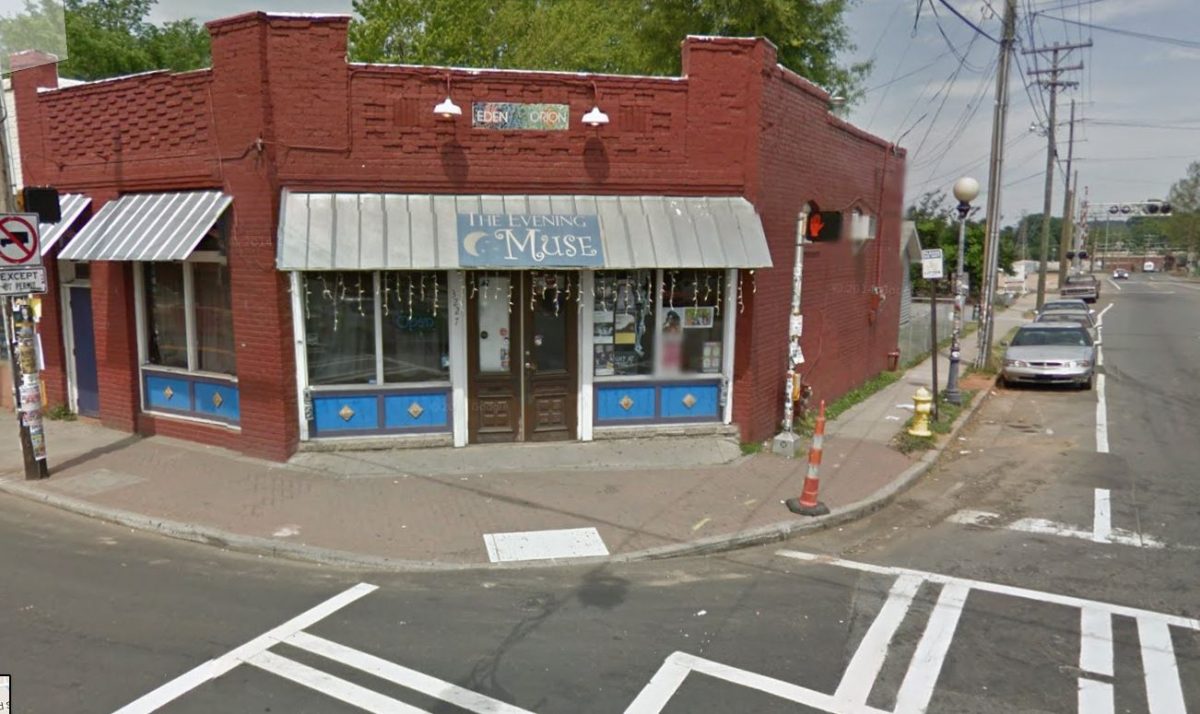
The Evening Muse at North Davidson and 36th streets is an old building that adds character to the NoDa neighborhood. How do planners take such buildings into account as they analyze development proposals? Photo: Google Street View
Q. Historic preservation was one of the top issues mentioned during five community workshops you held late last year. When a development is proposed, how do city planners assess whether any places of historic value might get wiped away? Not just landmarks but old buildings. I’m thinking of NoDa. It’s full of old buildings; most are not landmarks but they play a role in the neighborhood. How do you take that into account as you look at development proposals?
A. The way we do that now relies on the area plan and the policies in that area plan. There are area plans that will be specific about either historic landmark opportunities or other characteristics that should be protected. We rely on that adopted policy in an area plan, to make the analysis specific to a rezoning case. We’ve got historic districts as well, which have specific guidelines.
Q. A recent study from National Trust looked at how neighborhood character correlates to entrepreneurial activity. They found areas with a mix of building ages and smaller buildings had 33 percent more jobs in new businesses than areas with large, new buildings. Does Charlotte have any economic development and planning strategy to look at the size, age and form of buildings in an area as an economic development asset?
A. The simple answer is that we haven’t looked at it with that lens before. Intuitively, you might glean that kind of policy from an area plan, and protecting the form and scale of small businesses. And the concept is a little bit embedded in a PED overlay. It’s an interesting conclusion and it dovetails with something we intuitively know: that the scale of our development form makes places more walkable, more accessible, more vibrant. It sounds like what this study does is prove that those characteristics have an economic benefit.
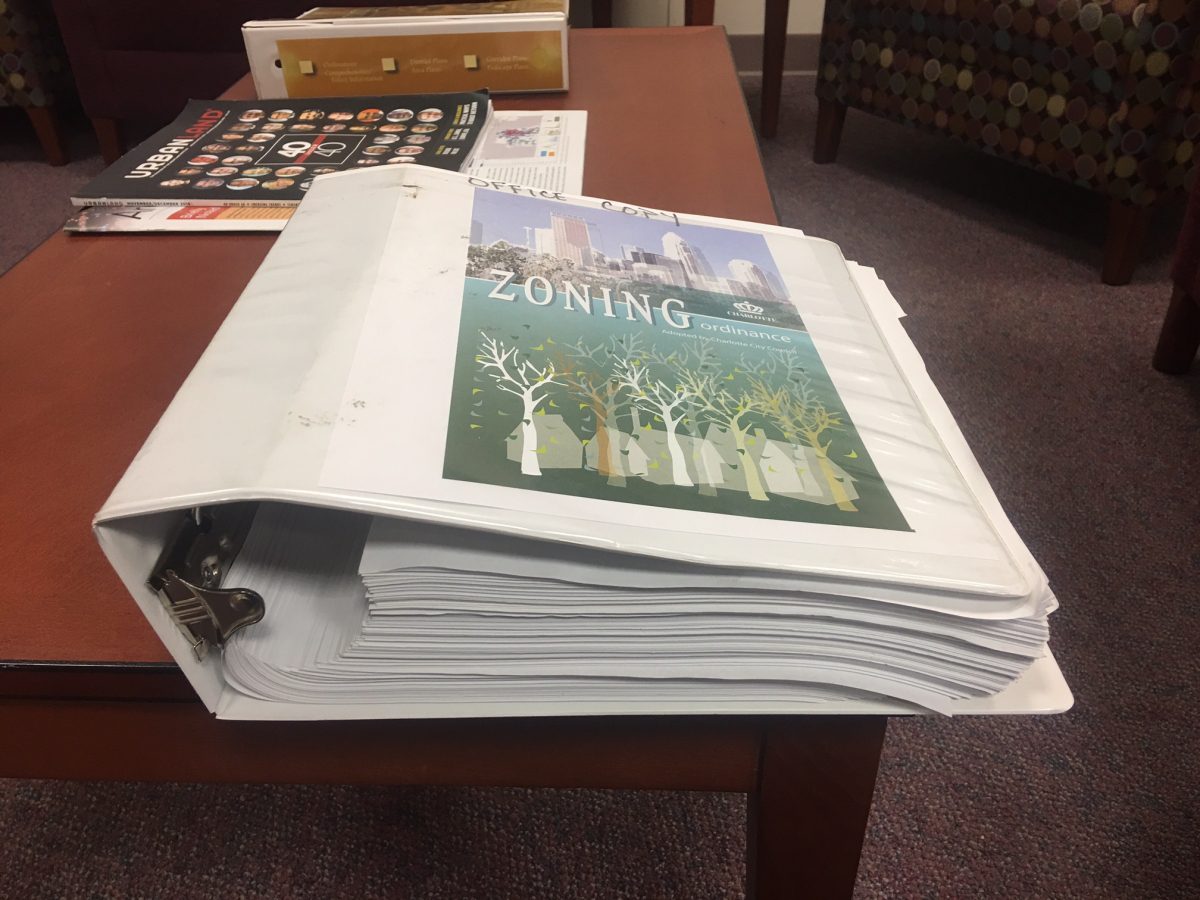
Charlotte’s current zoning ordinance: 830 pages. Photo: Mary Newsom
Q. Most of Charlotte is low-density suburbia, because of the era when the city’s huge growth began. You have to drive everywhere, so it’s really congested with a huge carbon footprint. Is the city’s best strategy to say: “Look we have these places. People like them. There’s a market for that. We’re OK with that.” Or, “We need to think about how we’re going to retrofit them over the coming decades.” What’s the best approach?
A. Not to sound political but I think it’s both. We have to recognize there’s a form and pattern that exist and a characteristic and quality of life that people are seeking out. But we have to recognize those places will change over time, and retrofitting or reinvestment will occur. And we have to begin to shape that.
To me the longer-term notion is that for us to be vibrant economically we have to recognize the demographics. We have an aging population, and we have a population that wants to be less reliant on the automobile. We need to have places where you have a set of options for housing – single-family up to townhomes, multifamily – and be within walking distance to the services that you need.
Q. If you had a magic wand and did not have to worry about what politicians would say, or your bosses, or what neighborhood groups would say, what would you change about the way Charlotte is developing?
A. What I would say is we’re heading in a direction where I think we need to be ever more intentional about the form and shape of our city. I think our ordinance will be the place where we can be more specific and more intentional and raise our expectations and raise the bar for the kind of development we want to see.